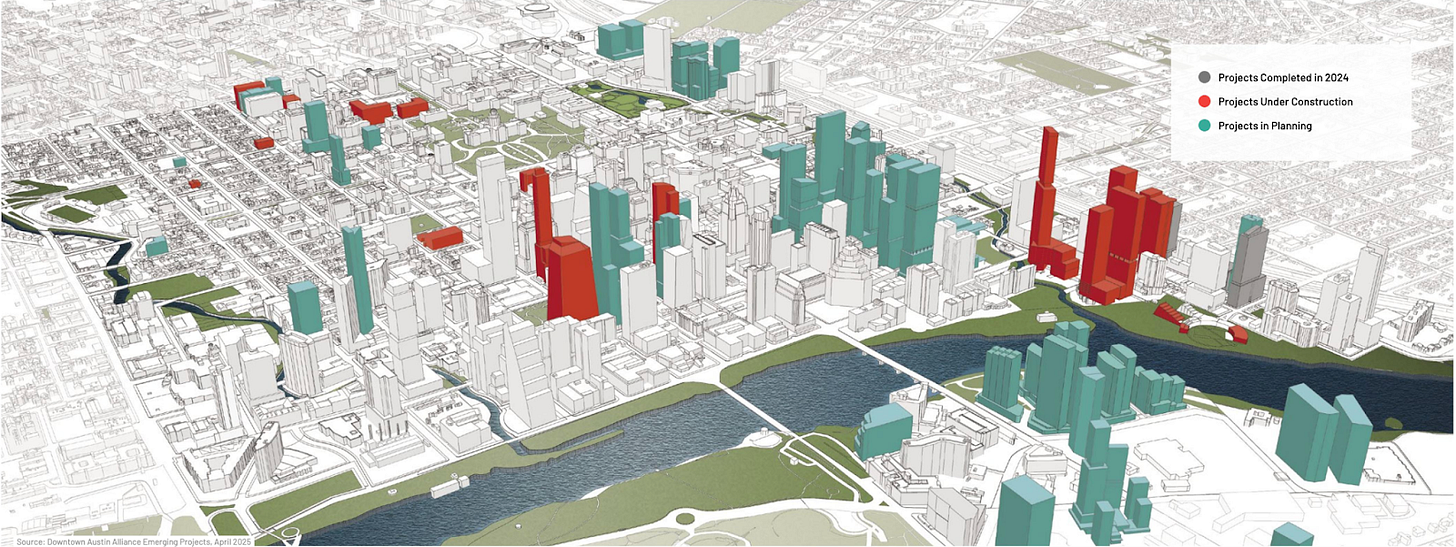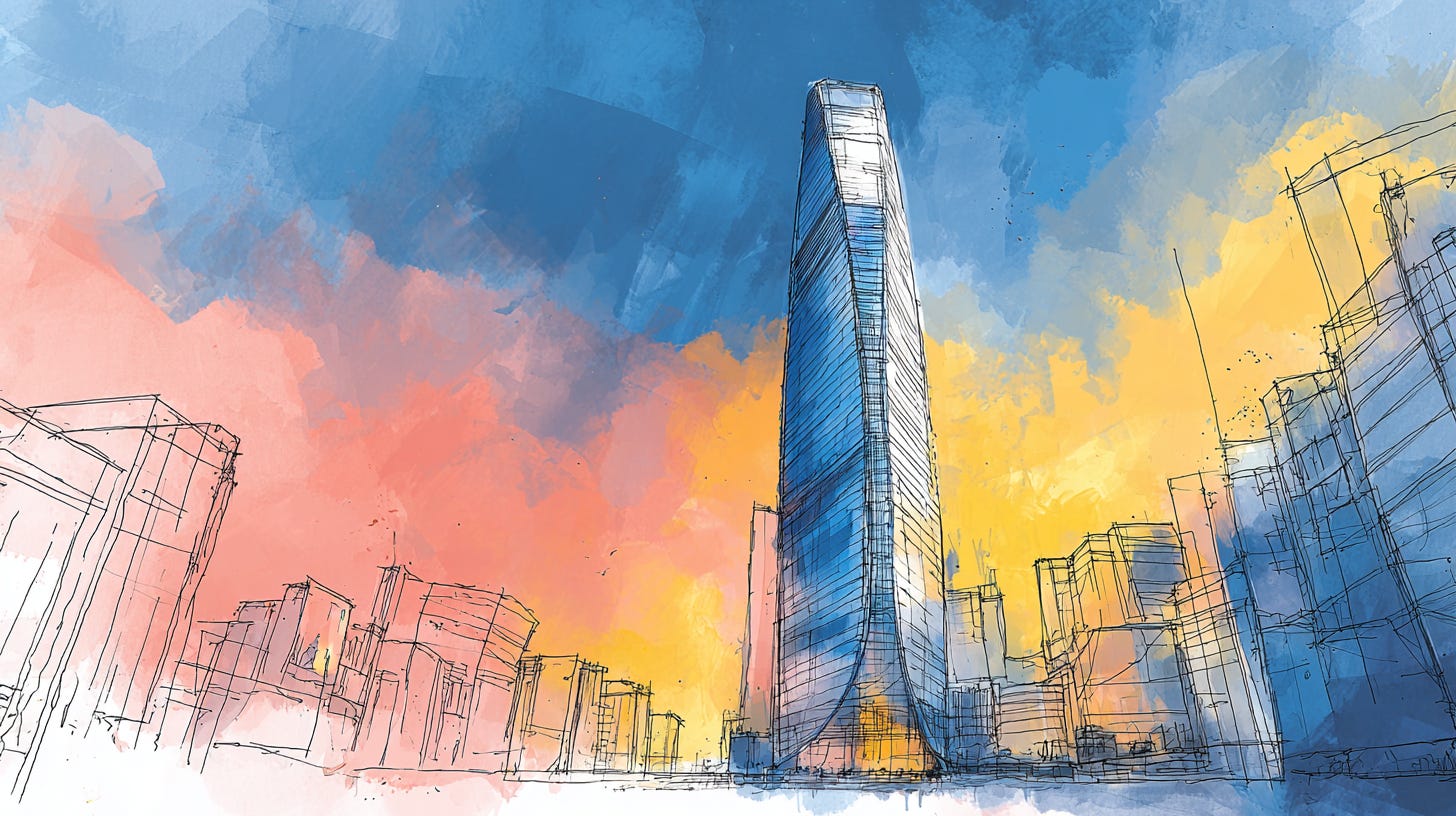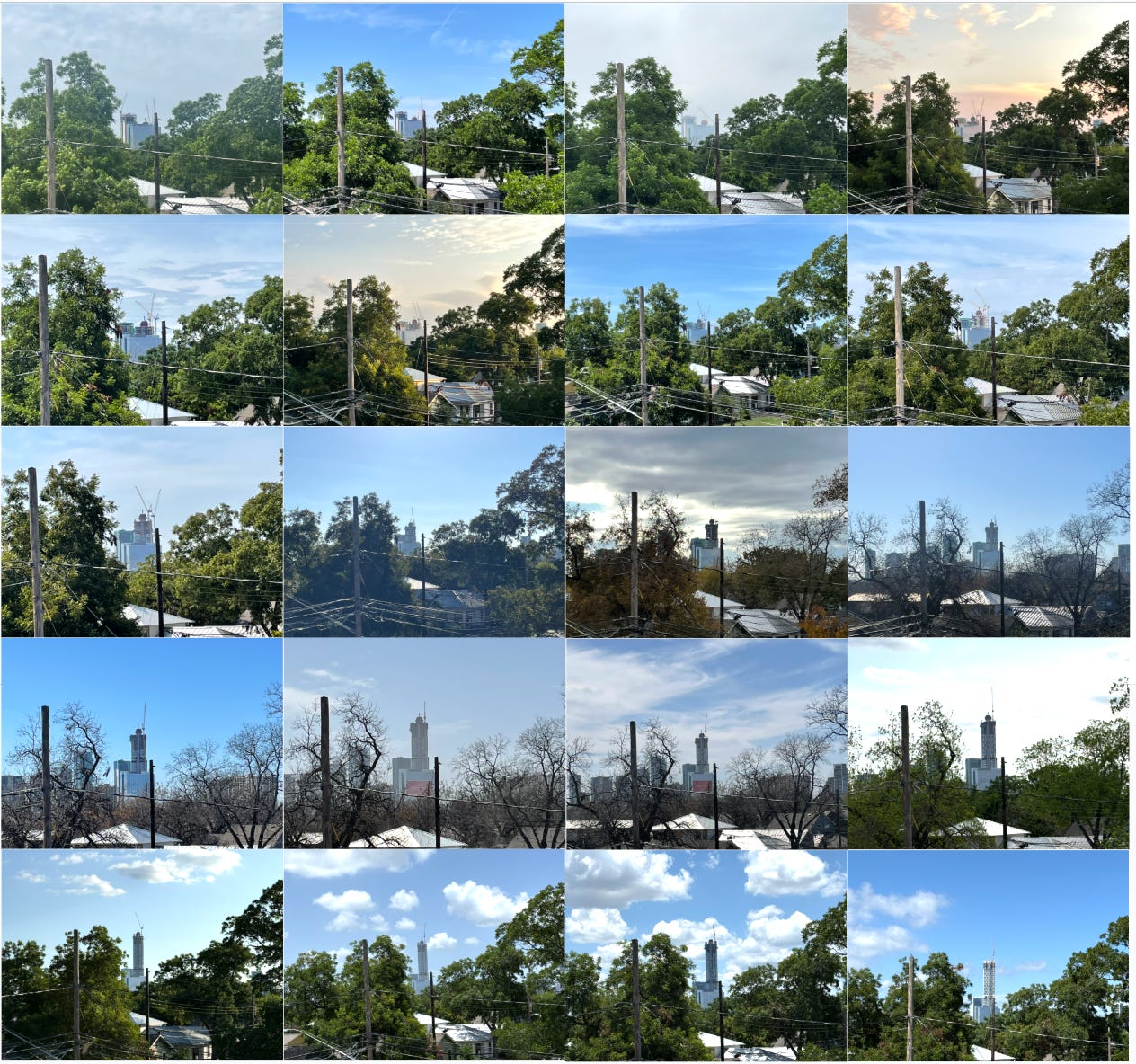The Last Skyscraper
Booms, Busts, and the Architecture of Belief
Over the past year, I’ve watched the last skyscraper rise in Downtown Austin. The Waterline, which recently topped out at 1,022 feet to become the city’s first “supertall,” stands about 1.3 miles from my porch, where I’ve charted its ascent since it peeked above the skyline.1 At first, only the cranes and concrete core were visible. But floor by floor, week by week, it climbed. As I watched, one lyric looped in my head, from an old favorite by Ben Folds Five: “Won't you look up at the skyline / At the mortar, block, and glass / And check out the reflections in my eyes?” As other buildings downtown reached their final heights and the cranes came down, they transformed the skyline reflected in my eyes—and now the Waterline is the only one I still see going up.
That lyric captured what I felt arriving in Austin in early 2022: the city had its share of challenges, but they were the challenges of growth—and the city was rising to meet them. The Waterline and its peers reflected a belief in Austin’s future, because to build a skyscraper is to believe in a city.
Skyscrapers are expressions of civic optimism in physical form.
They’re also strange things. Skyscrapers emerge from bedrock on the most rational of financial projections—and yet are often driven toward the clouds by some of the most starry-eyed dreams. Architect Cass Gilbert, who designed the Woolworth Building, once said that the purpose of a tall building is “to make the land pay.” But skyscrapers are more than economic machines—they’re symbols of hope.
That belief—the will to build skyward even as the ground gives way—was on full display in New York in the final days of the Roaring Twenties. On October 23, 1929, the Chrysler Building topped out at 1,046 feet, briefly becoming the tallest structure on earth. The very next day, Black Thursday triggered the stock market crash that would inaugurate the Great Depression. But just as the country fell into crisis, the Empire State Building began to rise—an audacious act of optimism at a moment when optimism had all but vanished.
To many, the quest to build the 1,250-foot Empire State Building was as emblematic of the aspirations and genius of the age as much as it was of its hubris and excess. By the time construction began, the economic rationale had also vanished. As the economy collapsed, developer John Jakob Raskob refused to let the Empire State become another casualty. Against all odds, and with millions of his own money at stake, he secured financing and drove construction at a record pace—4.5 stories per week. In thirteen months, it was done. As Neal Bascomb writes in Higher, for the crowds on Fifth Avenue below, “watching this leviathan rise at such a rate…many understood they were witnessing one of man’s greatest achievements.”2
If Raskob believed that the city and world needed a heroic show of optimism and achievement in the midst of calamity, he certainly paid for it. The Empire State wouldn’t pay for nearly twenty years, opening into a market already flooded with vacant space, as businesses shrank or failed. It earned the sobriquet “Empty State Building.” Meanwhile, across New York, record-breaking projects were shelved, and construction dropped fifty percent. The Empire State Building would be the last supertall skyscraper to be built in the city for forty years.
What’s happened in Austin over the past few years seems to echo that 1920s boom and bust.
By early 2022, Austin was in full boom. The housing market was a frenzy—homes listed on Friday were under contract by Monday. The real estate press buzzed with plans to replace low-rise warehouses and parking lots with towers: hotels, apartments, and even office buildings, despite the influx of remote workers. Our own home’s value jumped 10% in four months.3 That spring, glossy renderings of the Waterline debuted, exciting Austinites with the promise of hosting the tallest building in Texas. By fall, a rival developer announced the even taller Wilson Tower. Meanwhile, residential high-rises were sprouting across the city. It felt like Austin was living its own Roaring Twenties.
And then, just as quickly, it stopped. Interest rates rose, financing dried up, projects were put on ice. By 2023, Wilson Tower had been cut in half—and then disappeared. Sites cleared for towers returned to weeds. One by one, the cranes came down—until only one remained.
Soon, it too will come down, leaving behind a skyline transformed, but no longer in transition.
It’s tempting to imagine the Waterline as Austin’s high-watermark, much like the Empire State Building was for New York during the Depression. The city already has a glut of vacant office space—nearly 20 million square feet—and the Waterline will deliver 700,000 more. Luxury apartments have been slow to rent, and the building will add 350 more. It will also have a 250-key hotel, although tourism remains strong. That’s not to say Austin has stopped growing. Some residential projects are still underway, and midrise buildings continue to fill out the urban fabric. But nothing on the scale of the Waterline has broken ground since. The skyline, for now, is on pause.
So is the Waterline just another monument to extravagance?
Since the beginning, critics have always dismissed skyscrapers as symbols of excess—status objects for the ultra-rich, overbuilt trophies of a speculative economy. No doubt that has driven some of them. But this view treats cynicism as sophistication, when it’s often envy or fatalism in disguise.
Of the Empire State, Bascomb writes, “Not only was the skyscraper tall, but it was also gargantuan in proportion…and it went up like a rocket ship.” Whereas the late 1920s skyscraper boom was fueled by rivalries between architects and titans of industry, today’s tycoons compete to build actual rocketships, gigayachts, or survival bunkers—means of escaping life on earth. Conversely, a skyscraper represents a commitment to life on earth: it’s a vital piece of infrastructure in the life of a city and an investment in its long-term future—rooted in solid ground. A skyscraper anchors a city. It creates space for life to gather. Its presence reshapes the city around it, often permanently. Even as I admire the achievements of the rocketbuilders, I can’t help but feel a sense of civic abandonment, and I wonder what it means for our cities if today’s billionaire builders have turned their eyes toward space, the sea, or underground.
Indeed, I wish we did live in an age of skyscraper competition.
Because skyscrapers are not merely buildings, they are living monuments that reflect the optimism for the future in the era in which they were built. They aren’t just barometers of how much the land will pay—they’re beacons of belief, paying it forward. As Bascomb described the last skyscrapers of the Roaring Twenties: “All the exuberance, daring, romance, moxie, innovation, and pride that infused the decade is seen in these pinnacles.” They “reflected the spirit of a country in the making.” Would that our own age, for all its innovation and pride, have something of the romance of the last Roaring Twenties.
That spirit—the willingness to imagine taller, to plan bigger—is what sets a city in motion.
Not long ago, headlines warned of a “doom loop”—that empty offices and departing residents would trigger a cycle of urban decline. But that spiral has not materialized. Towers funded before interest rate hikes are now topping out in cities across the country. In Los Angeles, in Boston, in Atlanta and Charlotte, construction cranes still dot the skyline. In Miami, a global wave of luxury-condo buyers keeps pushing the skyline higher. In San Francisco, a city many had written off, developers are once again betting on the future—one has proposed the tallest tower on the West Coast. In New York, where land still pays, the race to the sky is still in motion, with three supertalls underway and more in the pipeline. Even in Austin, where the skyline feels paused, developers are still submitting plans—and a supertall could rise from the shell of the long-abandoned Hobby Building.
Some of these towers may eventually rise, while others will stall. The height of buildings may fluctuate with market conditions, but a stagnant skyline reflects a stagnant city—one that no longer believes in its future.
You don’t build a skyline if you think your best days are behind you.
City skylines are shaped in surges, in cycles of booms and busts. The Waterline may be the last spire of Austin’s Roaring Early Twenties, but it’s unlikely to symbolize an enduring bust. Regardless, it will remain a monument to Austin’s optimism and the city it still might become. Even the “Empty State Building” didn’t stay empty—by 1950, it was one of the most profitable buildings in the world. It finally made the land pay. The land in Austin will pay again, too.
Until then, I’ll keep watching the skyline—all that mortar, block, and glass—hoping that the next skyscraper will soon be reflected in my eyes.

A “supertall” skyscraper is more than 984 feet tall.
From Higher: A Historic Race to the Sky and the Making of a City by Neal Bascomb.
In this case, what goes up definitely comes down!





This article is chicken soup for the yimby soul. :) Thanks, Ryan!
great post - I share many of the sentiments expressed. I moved here in '94, and let's just say that the skyline is quite transformed since then. More than once, I thought the building boom was over (and so did many others). Maybe over for decades... in 2001/2. again in 2008/9. And even as Covid entered our lexicon. and each time, I was wrong.
this time we have another pause- but who can tell what happens next!
I'll share a brief thought as well about hope, and what a skyscraper can stand for. After 9/11, like many people, I found myself laid off from my first job out of college, one that I had worked hard at for 7 years, a place where I had a lot of respect, to which I tied much of my identity and value to. I loved that work, and the people I worked with.
As I started looking for work, Dice dot com was offering work for software engineers for $15/hour. My plumber charged $75/hour. It felt like it might be the end of software engineering and consulting as a gainful employment /profession, especially with companies so focused on moving jobs offshore, and the dot-com bust delivering so many bad financial returns to investors and companies. Many of my friends (indeed, most of my closest friends) moved away from Austin during that time, to try to reinvent themselves in San Francisco, Boston, New York, or LA.
During that time on the bench, I played a lot of ultimate frisbee over at Martin Middle School's fields on the weekends. (public park right next to the school). And from there, I had a good view of the Frost Tower going up. And I felt like it was a symbol that someone still believed in Austin. (And indeed, interviews with the folks who ran that project at the time indicated they did believe in Austin and they moved forward despite the headlines and they wanted Frost Tower to be a symbol of hope for Austinites with a memorable profile and crown as well). By the time Frost Tower opened I believe it was 85 or 95% leased. I found a contract to keep me fed in 2022, and a job in the summer of '23 that allowed me to afford an engagement ring for my wife, and a wedding. And that job (at Lombardi Software) led to the founding of BP3, which was the company that the building of defined the next 17 years of my professional life, and made possible so many things in my personal life.
Frost Tower was and is really important to me for that reason. And the idea that some people will power through - not just with hope, but by proving doubters wrong, and forging a new reality.